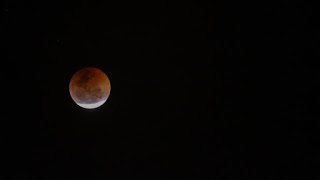It is a classic subject for nature photographers: a vividly purple flower
in the midst of white snow. Why is that image appealing to us?
in the midst of white snow. Why is that image appealing to us?
Part of its appeal comes from its aesthetic beauty -- so much so that it demonstrates what have long been held to be some of the identifying characteristics of beauty. One of those is that beauty is created when some features that might otherwise be experienced as being in conflict are instead held together in harmony. In this case, the intensity of purple contrasts with the absence of color in the snow; yet the two are held in harmony. The contemporary professor of religion Steven R. Guthrie, explaining this aspect of classical Western thought regarding beauty, writes that, "In Plato's dialogues... harmony in this sense is not uniformity or unanimity but the beauty that emerges from different elements in right relationship.... It is, in Dante's words, 'an order' from 'things disparate.' "
Most people like the image of the crocus in the snow. That favorable emotional response points to another aspect that the Western philosophical and theological traditions have identified as being a characteristic of beauty. Namely, that something beautiful creates a resonance within us that is pleasing. In that regard, Guthrie explains that " [Thomas] Aquinas draws our attention to the immediate impression that beautiful things make upon our senses."
In the case of the crocus in the snow, however, those who find the image beautiful are often responding to more than the aesthetic beauty of purple against white. A purple blotch on a white background would not elicit the same emotions that the flower does. What also resonates within us in the case of the crocus, even if unconsciously, is the contrast between the new life of the emerging flower and the surrounding cold snow of winter -- the season in which most plants die back. This additional form of contrast is also a dimension of the image's beauty that is pleasing to us. Not only is the tension between purple and white held together, but life and death are held together in a moment of harmony when the crocus emerges out of the snow. The 18th-century poet Christopher Smart, in his poem praising God, expressed how the crocus stands out from other plants around it. He wrote:
"The laurels with the winter strive;
The crocus burnishes alive
Upon the snow-clad earth."
The moment of plant-nativity displayed by the crocus can thus evoke within us that enduring quality of hope that sustains our human existence. Gandhi once wrote:
 "I do dimly perceive that whilst everything around me is ever changing, ever dying, there is underlying all that change a living power that is changeless, that holds
"I do dimly perceive that whilst everything around me is ever changing, ever dying, there is underlying all that change a living power that is changeless, that holdsall together, that creates, dissolves, and re-creates.... And is this power benevolent or malevolent? I see it as purely benevolent. For I can see that in the midst of death life persists, in the midst of untruth truth persists, in the midst of darkness light persists.
Hence I gather that God is Life, Truth, Light."
It is through our human capacity to not only resonate when experiencing aesthetic beauty but also respond to symbols that we can open ourselves to the transcendent dimension of reality. The crocus in the snow reveals to us more than the survival capability of a specific flower. It points to the Ultimate Ground of all existence. And in that Ground are the "flower-bulbs" and "seeds" of all that can be. There is an Indian saying that:
"All the flowers of all the tomorrows
are in the seeds of today."
The real challenge can be spotting those "seeds" and nurturing them. Sometimes we cannot even see them at all. But even when we cannot perceive them, we can hope, and like Gandhi we can have faith that they are there despite being hidden beneath the snow.are in the seeds of today."
~ ~ ~
(What do you hope for? Can you see any way you might contribute to that future growth of something good?)
(The Steven R. Guthrie quotation is from his book Creator Spirit:
The Holy Spirit and the Art of Becoming Human, © 2011. pp. 201-202 & 205.)
The Holy Spirit and the Art of Becoming Human, © 2011. pp. 201-202 & 205.)
(The lines by Christopher Smart are from "A Song to David,"
taken from Encompassing Nature, ed. Robert M. Torrance, © 1998, p. 1015.)
taken from Encompassing Nature, ed. Robert M. Torrance, © 1998, p. 1015.)
(The Gandhi quotation is from his Young India, 11-10-28, as quoted in Gleanings from
the writings of Mahatma Gandhi bearing on God, God-Realization and the Godly way, ed. R. K. Prabhu.)
the writings of Mahatma Gandhi bearing on God, God-Realization and the Godly way, ed. R. K. Prabhu.)



























